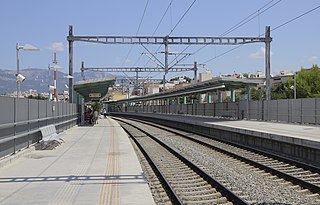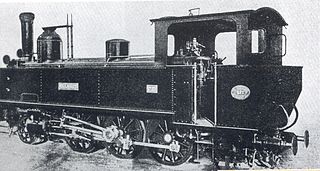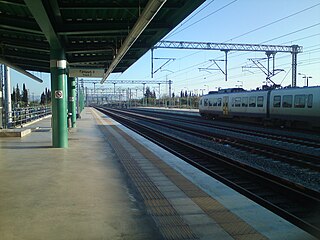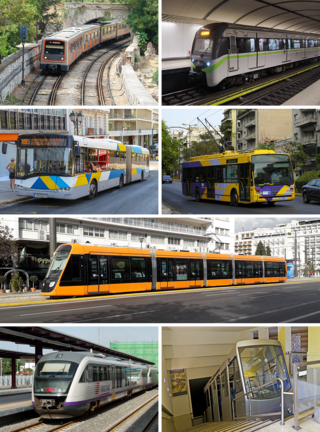Transport in Hungary relies on several main modes, including transport by road, rail, air and water.

The National Roads and Motorways in Greece constitute the main road network of the country. These two types of roads are distinct in terms of their construction specifications. Their main difference is that motorways adhere to higher quality construction standards than National Roads.

The Athens Metro is a rapid-transit system in Greece which serves the Athens urban area. Line 1 opened as a single-track conventional steam railway in 1869 and was electrified in 1904. In 1991, Elliniko Metro S.A. constructed and extended Lines 2 and 3. It has significantly changed Athens by providing a much-needed solution to the city's traffic and air pollution problem, as well as revitalising many of the areas it serves. Extensions of existing lines are under development or tender, like the Line 2 extension to Ilion where tender started in 2023, as well as a new Line 4, whose central section began construction in October 2021. The Athens Metro is actively connected with the other means of public transport, such as buses, trolleys, the Athens Tram and the Athens Suburban Railway. The Athens Metro is hailed for its modernity, and many of its stations feature works of art, exhibitions and displays of the archaeological remains found during its construction. Photography and video-taking is permitted across the whole network and street photographers often work in Athens Metro. This is the only metro system in Greece, until the Thessaloniki Metro begins operation in 2024.

The Proastiakos is Greece's Commuter rail service, run by Hellenic Train, on rail infrastructure owned by the Hellenic Railways Organisation (OSE) (lines) and GAIAOSE. These services connect a participating city's central railway station to important locations such as a city's port or airport, as well as its suburbs and occasionally nearby towns and cities.
Greek vehicle registration plates are composed of three letters and four digits per plate printed in black on a white background. The letters represent the district (prefecture) that issues the plates while the numbers range from 1000 to 9999. As of 2004 a blue strip was added on the left showing the country code of Greece (GR) in white text and the Flag of Europe in yellow. Similar plates but of square size with numbers ranging from 1 to 999 are issued for motorcycles which exceed 50 cc in engine size.

The Hellenic Railways Organisation or OSE is the Greek national railway company which owns, maintains and operates all railway infrastructure in Greece with the exception of Athens' rapid transit lines. Train services on these lines are run by Hellenic Train S.A., a former OSE subsidiary, Rail Cargo Logistics Goldair, Pearl and Grup Feroviar Român.

Doukissis Plakentias, sometimes known simply as Plakentias, is an Athens Metro and Suburban Railway station situated at the end of Doukissis Plakentias Avenue in Chalandri, a municipality in the regional unit of North Athens, Attica, Greece. It is named after the Duchess of Plaisance, a philhellene who owned much of the land in the part of Attica where the station now stands. The metro station lies underground, while the Suburban Railway station lies within the median strip of the Attiki Odos motorway.

The Acharnes Railway Center or SKA is a two-level railway station in the northern parts of the Athens agglomeration, in the suburb of Acharnes, where several important railway lines converge. It is an important passenger interchange station linking The main Piraeus–Platy railway line from Athens Central to Thessaloniki and the Athens Airport–Patras railway. The station opened in April 2011.

The Lavrion Square–Strofyli railway was a Greek 1,000 mm railway line that ran from Lavrion Square in downtown Athens to the suburb of Kifissia and further on to Strofyli.

Rail transport in Greece has a history which began in 1869, with the completion of the then Athens & Piraeus Railway. From the 1880s to the 1920s, the majority of the network was built, reaching its heyday in 1940. From the 1950s onward, the railway system entered a period of decline, culminating in the service cuts of 2011. Ever since the 1990s, the network has been steadily modernized, but still remains smaller than its peak length. The operation of the Greek railway network is split between the Hellenic Railways Organisation (OSE), which owns and maintains the rail infrastructure; GAIAOSE, which owns the building infrastructure and the former OSE rolling stock, Hellenic Train; and other private companies that run the trains on the network. Greece is a member of the International Union of Railways (UIC). The UIC Country Code for Greece is 73.

Piraeus, Athens and Peloponnese Railways or SPAP was a Greek railway company founded in 1882, which owned and operated the 1,000 mm Piraeus–Patras railway line connecting Piraeus and Athens to Peloponnese. The company was nationalized in 1954 and absorbed by the Hellenic State Railways in 1962.

Attica (Greek: Περιφέρεια Αττικής, romanized: Periféria Attikís, is one of the 13 regions of Greece based on Article 61 of Law 1622/86, as defined by Presidential Decree 51/1987, consisting of the Prefecture of Attica with headquarters in Athens. The region is coextensive with the former Attica Prefecture of Central Greece and covers a greater area than the historical region of Attica.

Kiato railway station is a station in Kiato in the northern Peloponnese, Greece. The station is located 1 km west of the town, near the A8 motorway between Athens and Patras. It was opened on 9 July 2007. The station is served by the Athens Suburban Railway towards Piraeus and Hellenic Train local services to Aigio. It should not be confused with the now-closed station on the old Piraeus–Patras railway, which is located northeast of the current station, closer to the coast of the Corinthian Gulf.

Athens railway station is the main railway station of Athens, and the second largest station in Greece. Located in the central quarter of Kolonos, the railway station resulted from the merger of two separate railway terminals in 2005—Larissa station of the Piraeus–Platy railway towards central and northern Greece, and the Peloponnese station of the Piraeus–Patras railway that formerly linked Athens with the Peloponnese.

The railway from Piraeus to Platy is an electrified double-track railway line that connects Athens to northern Greece and the rest of Europe. It constitutes the longest section of the mostly completed higher-speed rail line known as P.A.Th.E./P., which includes Greece's most important rail connection, that between Athens and Thessaloniki. Its northern end is the station of Platy, on the Thessaloniki–Bitola railway. In the south, it connects to the Athens Airport–Patras railway at the Acharnes Railway Center. The line passes through Thebes, Katerini and Larissa, and offers connections to several other cities through branch lines.

Athens "Kifissos" Bus Station, also known as KTEL Kifissos Bus station, is the busiest intercity bus station in Athens. It is the largest bus terminal in Athens and the second-largest in Greece, the largest being the Thessaloniki "Macedonia" Intercity Bus Station. It is located in Peristeri towards Kifissou Avenue or European route E75. There are a lot of routes to Peloponnese, Epirus, Macedonia and Ionian Islands. For Thessaly and Central Greece there are routes from the second intercity Bus Station of Athens in Patisia known as "Liosion Bus Station". Both of these stations will be replaced with the new Central bus station being built in Eleonas by 2025.
Paiania–Kantza is a station located north east of the suburban town of Paiania in Athens, East Attica. located in the median strip of the Attiki Odos motorway. This station first opened to Athens Suburban Railway trains on 30 July 2004, with Athens Metro services calling at this station from 10 July 2006.

The railway from Athens Airport to Patras is a double-track, standard-gauge railway line in Greece that, when completed, will connect Athens International Airport with Patras, the country's third-largest city. One of the largest railway projects of the last 30 years in Greece, its completion is of major significance for the infrastructure of the entire region of the northern Peloponnese. As of 2020, the line is completed until the city of Aigio. A 5.2 km underground section is planned for the final section from Kastellokampos to Agios Andreas in Patras. For most of the section between Athens Airport in East Attica and Mandra in West Attica, the line runs along the median strip of the Attiki Odos motorway.

Public transport in Athens comprises a bus network, various rail systems, funiculars, and maritime services to serve the more than 4 million inhabitants of the city spread over an area of 2928 km2.

Megara railway station is a station in the municipal unit of Magoula of the municipality of Elefsina, West Attica, Greece. It is located adjacent to A8 motorway between Athens and Patras. It was opened on 18 July 2006 as part of the extension of the Athens Airport–Patras railway to Corinth It has two side platforms and a siding. The station is served by the Athens Suburban Railway between Piraeus and Kiato. The station has a similar design to Ano Liosia railway station. The station serves the adjacent Thriasio hospital.





























